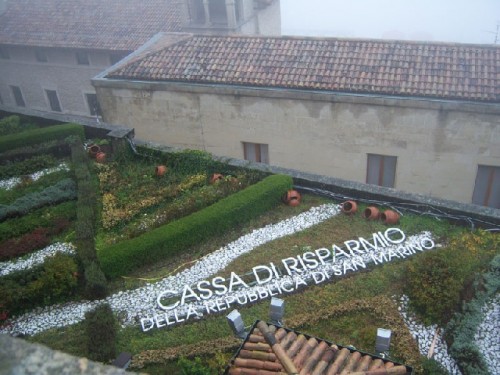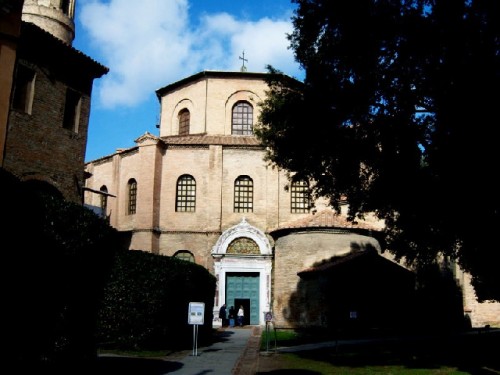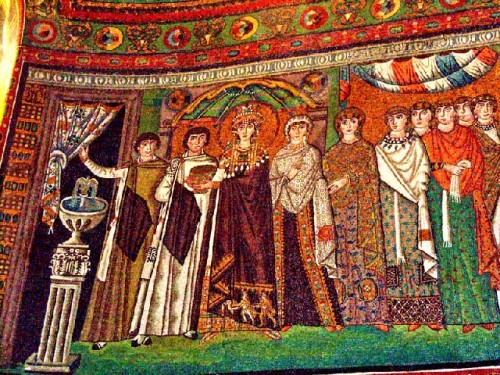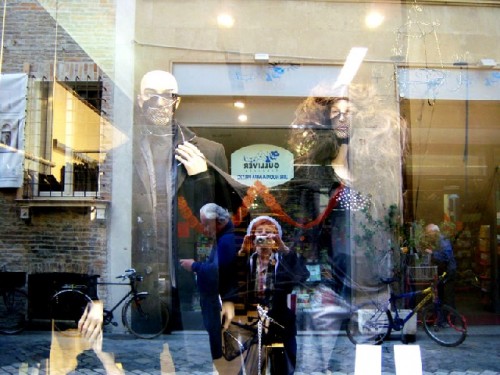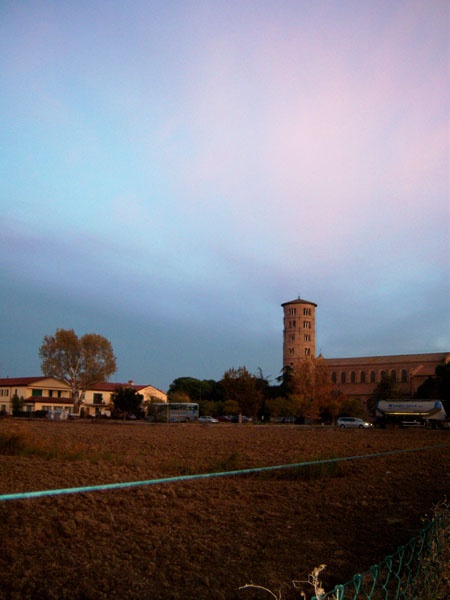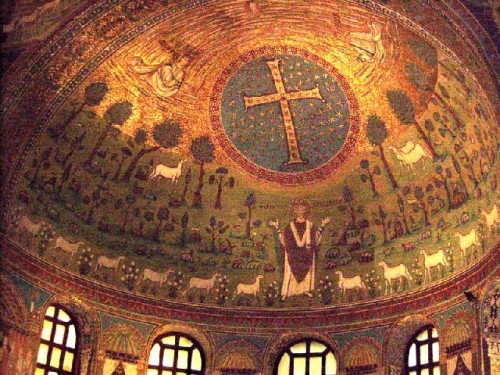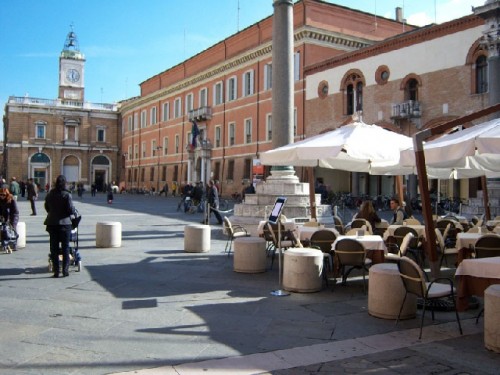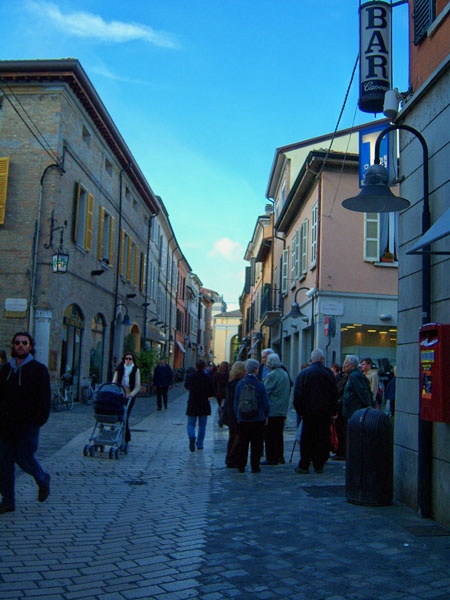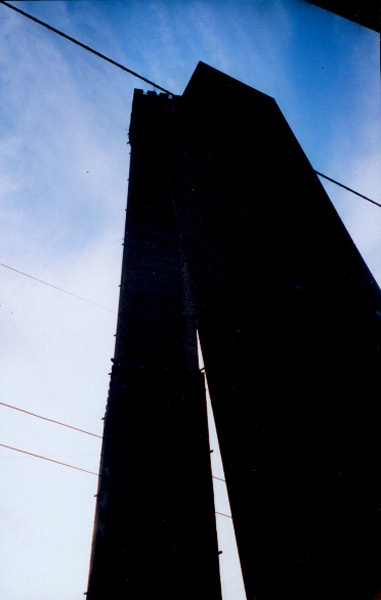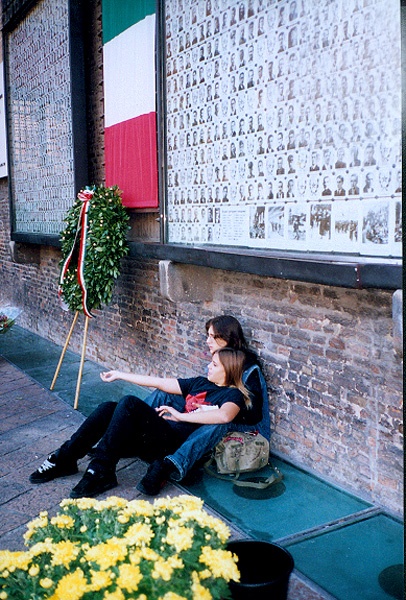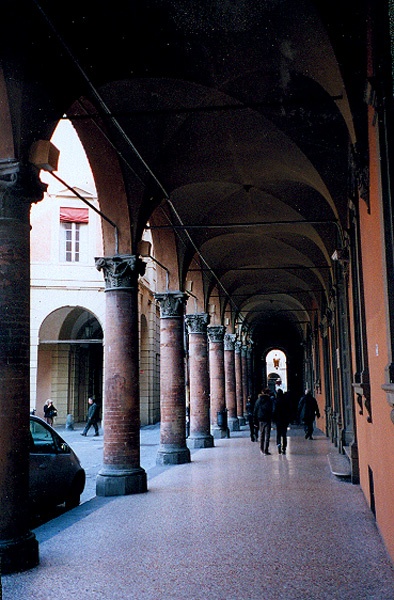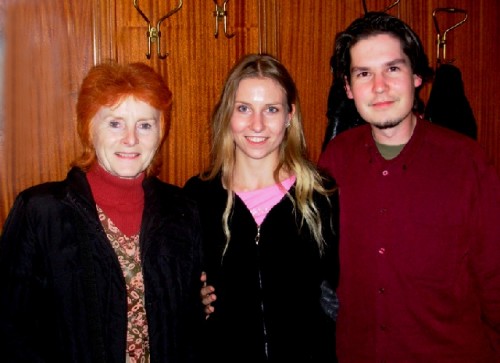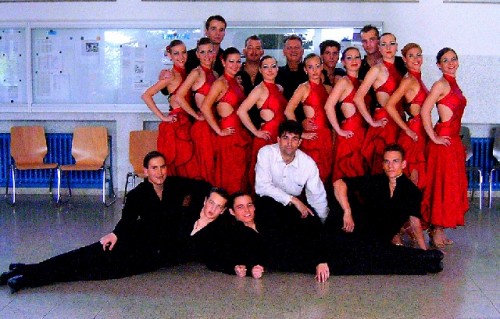Impressions of Northern Italy: Part Two
Rimini/ San Marino, Ravenna, Bologna and Milan
By: Astrid Hiemer - Dec 09, 2007
Rimini/San Marino
From Venice and its relatively quiet waters in the canals we traveled to the stormy Adriatic Sea. Oh, what a contrast and welcoming moment, since we love the oceans. Rimini is the biggest summer resort in Italy, but out of season, and in rainy weather, a bit sad. The walk on the beach filled our lungs and hearts. We came to visit San Marino (Serenissima Repubblica di San Marino) for a day and the one hour bus ride from Rimini was most convenient. San Marino is a City State in the middle of Italy without any controls for identification or need to a currency change. It is built around Mount Titano and the Bonnelli bus line stop was close to the main gate, Porta San Francesco. One walks up medieval footpaths, with enough room for small cars. Its major income derives from tourism, and, as someone joked, from stamps. (I well remember my childhood stamp collection contained most beautiful San Marino stamps.)
It is a heavily fortified medieval hilltop Republic with cobblestone walkways. Both sides of the streets are lined with shops, expensive stores, restaurants, and hotels. It is complete with three castles, a church, prison, and three towers containing museums, one of which is the Torture Museum. Many of the structures date back to the 13th Century. San Marino has a magnificent 360 degree view into the valleys, which are dotted with beautiful homes, estates, and hotels. However, on the day of our excursion, a heavy fog would not lift! As we were bravely balancing along a tiny footpath and bridge without a hand rail, but a steep drop-off, we could not even see the church above us. Finally, shortly before the bus returned to Rimini, we had a glimpse at what friends described as "definitely worth visiting and breathtaking vistas."
Ravenna
I skipped over Ravenna, where we stayed for two nights after Venice. However, I will never forget the almost 1500 year old Byzantine mosaics in the Basilica di San Vitale, several other churches, and baptistery. The Basilica has a 6th Century transept and a 10th Century crypt. We were intrigued by the yellow or golden light emanating from the alabaster covered windows in many of the churches. Some of the most memorable golden mosaics were those of Emperor Justinian and his wife Theodora, the ceiling in the Mausoleo di Galla Pacidia behind the basilica, and in the Battistero degli Ariani. The Arian sect worshipped in the baptistery. They were one of many splinter groups of the early Christian Church, and were condemned as heretics. The attendant told us, that the small building had actually sunk more than two meters over time, which accounts for a more than six feet lower ceiling.
The mosaics in the Chiesa di Sant'Apollinare in Classe were also exquisite. The basilica dates back to the 6th Century and was built a distance away from town. We had to choose between visiting the tomb of Dante Alighieri and the Dante Museum, or taking the Number Four Bus to Classe, a suburb of Ravenna. We took the bus. – Ravenna's old city core is well maintained and very comfortable to visit. Everyone is either on foot or riding a bicycle, a sight, which appears frozen in time. Ravenna, we will return – someday.
Usually, we would arrive at our next destination in the late afternoon, settle into the hotel, where we would stay for two nights and ask for recommendations to a fine but reasonably priced restaurant. In Ravenna, we dined one evening at an Indonesian restaurant nearby. It appeared a bit out of context, but was well known in town. The restaurant served a sizeable buffet dinner and the food was delicious. Yet, a travel video of the islands played silently and continually and conveyed busy city life, a lush countryside, and beautiful beaches. It was even more enticing than the food. We ate at the Trattoria La Rustica the following evening and were served tasty regional dishes, which included fresh strozzapreti, a yummy pasta, and rabbit. The house wine, which in most restaurants is served on tap, cost here and elsewhere five or six Euros for a half litre carafe, quite reasonable and enjoyable. From our table we observed three bachelors, eating alone. One had ordered a fine bottle of wine. Clearly, they were used to eating out by themselves. There were also local couples and travelers from Southern Germany. What fun to people-watch.
Bologna
Bologna was our next destination. The "Albergo Panorama" was relatively close to the train station, in the center of the City, so that we arrived by taxi. What a relief! The black, wrought iron staircase and tiny elevator inside an elaborately designed wrought iron cage, reminded me of a 19th century Parisian style, which was probably the same time period, when this neighborhood was built. The city center has miles of loggias, covered walkways, as part of the housing complexes. The Albergo was only a five minute walk away from the Piazza del Nettuno, the Piazza Maggiore, and the Basilica di San Petronio, Bologna's cathedral. As one turns into the Piazza del Nettuno from Via Ugo Bassi, the first sight is the "erotic" Neptune Fountain. Behind the fountain we were confronted by a memorial, three big tableaux of photographs of men and women, who died as Resistance Fighters against Fascism in WW II. It was also a reminder, that Bologna was then, and is today, politically and culturally a liberal and left leaning city. Bologna's university, still in the center of town, is Europe's oldest and was founded more than 900 years ago.
The visitor's line to enter the Basilica di San Petroni was relatively short in October. One could not carry large bags or back packs, so we took turns. The Gothic Cathedral is huge and magnificent. It was designed by Antonio da Vincenzo in 1390 and was to be built larger than St. Peter's Basilica in Rome. The Church in Rome would not allow it and instead, the nearby Palazzo Archiginnasio was erected. The palazzo is the Public Library today, and we signed up to use the library's free and public computers.
Leaving the Piazza Maggiore, there were the old market streets with vegetable and fish stores, their wares being offered along the sidewalk. Delicatessen stores, had many whole prosciutti – cured hams – hanging from the ceiling and most deliciously looking food was offered in glass vitrines. There were bakeries and fresh pasta in many shapes and sizes. Big wine barrels were used as tables in an adjacent street, offering a menu of wines and tidbits for lunch. It was a bit cold, but customers were a plenty. Instead, I had a special gelato, which a friend urged me to try. Well, that was even colder, but delicious and authentic.
We spent three nights in Bologna. On our first full day we visited some of the major sites: The piazzas, basilica and churches. One of the two remaining towers in the city, once there were two hundred, the Torre degli Asinelli can be climbed. The Pinacoteca Nazionale exhibits a Giotto altar piece, a Raphael, many Bolognese artists, and works from Primitivism to Mannerism. On the second day we decided to make discoveries, and wandered into an exhibition of photographs and a video/film presentation of the Greek tragedy, "Medea." Paolo Pasolini made the film, in 1969, with Maria Callas in the title role. Callas' most touching scene evolved as she bathed her two small sons lovingly for the last time, before she killed them to take revenge on her husband, who had left her to save his political position. Callas and Pasolini presented an outwardly emotionally controlled Medea in that film, which we viewed entirely. The photographs, exquisite prints, were shot during the filming of "Medea." The cinematography was extraordinary, with its desert settings and adobe-like buildings, colorful and intricate costumes. The exhibition was a beautiful find. Later, we walked along the medieval quarter of the city, had tea and snacks allowing the day to sink in.
We dined at two fine trattorias the following nights, as always very enjoyable. At the Trattoria Danio we spent one evening with a young Hungarian couple, who are indeed world travelers. Szabolcs Mosonyi has meanwhile become a BFA contributor, and one can read his African adventures in this Internet Magazine. His fiancée, Andrea Gajdatsy, is a member of a very prestigious Latin Dance group in Budapest, the "Botafogo." Andi has won bronze, silver, and gold medal places with her fellow dancers in Hungarian, European and World Championships in Latin Dance, or Visual Dance Formation, since 2003. How impressive. She reminds me of my own youthful travels in Track and Field competitions with the Club HSV (Hamburger Sports Verein). I competed for ten years, before immigrating to the USA in my early twenties.
Booking our train ride the day of departure, proved to be a bit hazardous. We boarded the train without seat reservations, and made it onto the train by determination and luck. It was the busiest travel day of the year. Sunday, November 4th, was the day before a National Holiday, and we ended up standing in the aisle, halfway sitting on our suitcases. A woman who had been complaining loudly since Rome about the "extra" passengers was still at it. (Rome-Milan, a six hour ride, and the entire wagon had no reserved seating.) 90 minutes later, we actually found seats, left by departing passengers, and were elated. The woman received a "cursing-good-bye" from a passenger upon her departure and Charles started a round of applause, when she left, finally looking sheepishly and hurt. But, we also had wonderful company in our booth with a young Korean woman, who was studying in Australia. She was competent in Italian and kept us informed. Well, the world is getting ever smaller – while traveling.
Milan
The Hotel Demo on our return to Milan was close to the central railroad station. It turned out to be a good choice and location, because frequent buses to the airport departed for the one hour trip. We arrived at the airport at seven in the morning and cleared security quickly. We had reached the end of our Italian adventures. By the time we arrived home, we had barely slept for the last 40 hours and were glad to rest in our own bed, but not for long. Let's go!

